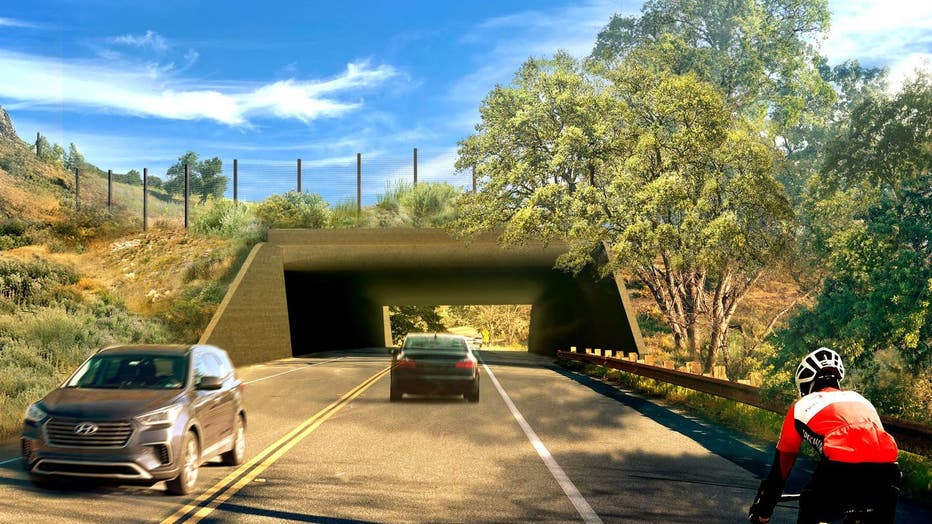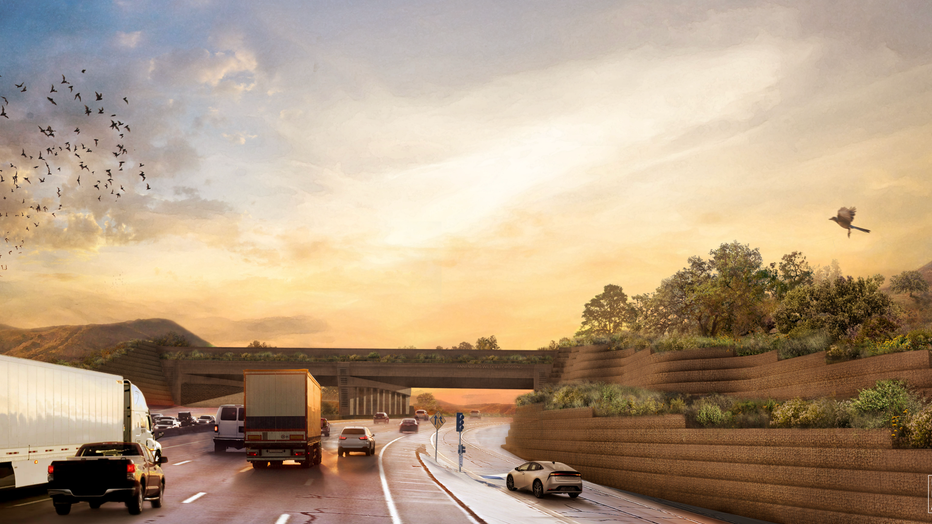101 Freeway wildlife crossing reaches final phase

Crews lay first soil on SoCal wildlife crossing
The crossing will be the largest of its kind globally, featuring 5,000 native plants to support diverse wildlife.
LOS ANGELES - Wildlife officials are celebrating the start of the second and final stage of the Wallis Annenberg Wildlife Crossing in Agoura Hills.
What we know:
Wildlife officials announced Wednesday that the second and final stage of the Wallis Annenberg Wildlife Crossing in Agoura Hills is now underway.
Crews are beginning construction on a secondary structure that will span Agoura Road, connecting to the existing portion of the crossing over the 101 Freeway.
SUGGESTED: Crews lay first soil on Agoura Hills wildlife crossing
Upon completion, the entire crossing is expected to become the largest wildlife bridge in the world and serve as a global example for urban wildlife conservation efforts.

What's next:
The final phase of the project, while spanning a smaller local road, is considered more complex than the freeway portion.
It requires an extensive foundation due to its width, which matches that of the freeway structure.
Significant earthwork is needed to connect habitat areas, reconstruct hydrology, and restore the landscape while protecting existing creek watersheds and heritage oak trees.
Additionally, important utility lines running parallel to the freeway must be relocated through a multi-agency effort.
SUGGESTED: Construction continues on Agoura Hills wildlife crossing over 101 Freeway
The placement of thousands of native plants on the crossing, originally slated for this spring, has been rescheduled for this fall.
This adjustment was made to optimize success by avoiding the summer heat, following supply chain issues and construction scheduling.
The backstory:
The project achieved a major milestone earlier this year with the completion of the structure over the 101 Freeway.
This involved pouring over 26 million pounds of concrete, finishing vegetated sound walls, placing planting soils, installing natural stone habitat elements, and unveiling the crossing's name, which is now visible daily to more than 300,000 drivers.
Over the last three and a half years, a dedicated and Indigenous-led nursery team has hand-collected more than 1.1 million hyper-local seeds from over 50 distinct native plant species in the Santa Monica Mountain plant communities.
SUGGESTED: 101 Freeway closed nightly at these roads for wildlife crossing project construction
These seeds have been grown in the project's native plant nursery in preparation for the fall planting.
This seed collection and nursery work is ongoing and is part of a broader ecological restoration plan to revitalize acres of open space in the Santa Monica Mountains, requiring 50,000 native plant and tree species.

Photo courtesy Rock Design Associates and National Wildlife Federation
What they're saying:
California Governor Gavin Newsom expressed his support for the project's progress.
"Today, the state is beginning the final phase of construction for what will soon be the largest urban wildlife crossing in the world -- all thanks to the visionary work of state, federal, and private partners," Gov. Gavin Newsom said. "The Wallis Annenberg Wildlife Crossing will soon protect Los Angeles' native wildlife and over 300,000 drivers daily, as well as provide a cutting-edge model for urban wildlife conservation."
Wallis Annenberg, chairman, president, and CEO of the Annenberg Foundation, highlighted the significance of each construction phase.
"Every stage of construction of this vital crossing is another step toward the survival of the vibrant animal and plant life that form the remarkable ecosystem of this region," said Wallis Annenberg.
SUGGESTED: Final girder installed at wildlife crossing
"The sophistication of the structure reflects the immense care and attention to detail that have brought us to this final phase. I am so proud to partner with and to champion the efforts and excellence of everyone involved."

Beth Pratt, California regional executive director of the National Wildlife Federation and leader of the #SaveLACougars campaign, emphasized the collaborative effort.
"This crossing is a story of hope -- a hope for a better future for wildlife. And a story of partnership and collaboration. Building a wildlife crossing over one of the largest and busiest freeways in the country, and in one of the most densely populated areas in the United States, came with immense challenges," said Beth Pratt. She added, "But because so many people -- the agency teams, elected officials, scientists, donors, artists, volunteers, the communities, and the public at large -- united around the important cause of protecting mountain lions and all wildlife in the Santa Monica Mountains, this visionary dream has become a reality."
The Source: Information for this story is from the Annenberg Foundation and National Wildlife Federation,

